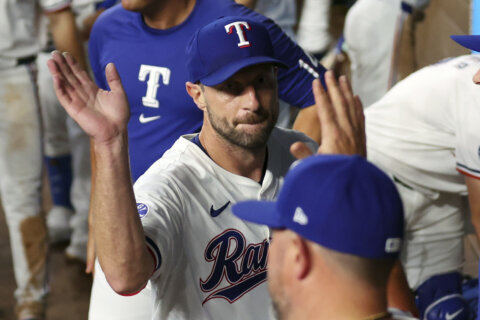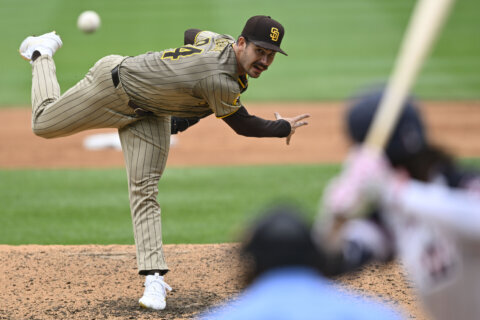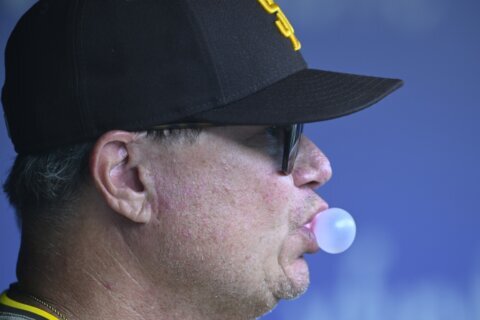This has been a busy offseason in Washington, especially in the last few days. After spending big on one free agent, the Nationals have taken a quantity-over-quality approach to the rest of their shopping list.
This is a strategy setting them up with more options and flexibility in the roster, but less high end talent entering the 2020 season as they look to repeat as champions.
It’s no secret where Washington has pooled its resources. The Nationals have committed just shy of $100 million to the top four starters in their rotation for 2020.
That was the strength of the team throughout the postseason last year, and with a likely diminished offense, will be looked to again to shoulder the load this year.
Based on wRC+, FanGraphs’ Steamer projections expect just four Nationals batters to produce better than league average offense, with Juan Soto (145) far outpacing Howie Kendrick (117), Trea Turner (111) and Adam Eaton (109).
Baseball Reference is even less optimistic, with lower projections for everyone above, other than Kendrick.
The Nats were sixth in the NL in home runs, but lost Rendon’s 34 from last year. Maybe more crucially, they led the league in on-base percentage, but are replacing Rendon’s .412 mark over 646 plate appearances with a collection of players that have historically reached at a much lower rate.
Before we get into salaries, it’s important to state clearly, once again: The Nationals can afford any player on the market. They could have afforded to keep Rendon. Doing so might have put them over the luxury tax threshold, but again, that is something they could have afforded to do, if they chose to.
That being said, the following salary constraints will be discussed within the framework of the team staying under that mark, as that seems to be an organizational goal, for better or for worse.
Once Rendon left for Anaheim, the Nationals became frequently mentioned as heavy suitors for free agent third baseman Josh Donaldson, as well as potential trading partners with the Chicago Cubs for Kris Bryant or the Colorado Rockies for Nolan Arenado.
While any of the above would go a long way toward replacing Rendon’s production at third, they would all carry significant salary obligations. Combined with the moves already made, any of the above additions seem like they would all push the Nats up to or north of the luxury tax threshold, barring some Major League salary going the other way in a trade.
That leaves essentially one more Major League infield roster spot for Ryan Zimmerman, who just about everyone seems to think will return on a short deal. It also leaves the team with a small amount of flexibility to operate and take on salary in-season, as contending teams often need to do in order to add pieces at the trade deadline.
Here’s a look at the major free agent signings so far:
SP Stephen Strasburg: 7 years, $245 million
The first big splash of the offseason featured the return of the World Series MVP to Washington, on a much heftier contract than the remaining four years of his prior extension. It always seemed like Strasburg would return, and the bet on himself in opting out of his guaranteed $100 million paid off handsomely.
It represents more money in the first year of the contract alone than the Nats have given to every other free agent combined for 2020.
C Yan Gomes: 2 years, $10 million ($4M in ’20 / $6M in ’21)
Gomes’ return keeps the same backstop tandem in place from 2019. After an offensive drop-off from his 2018 All-Star campaign, there’s reason to hope Gomes might provide a little more at the plate this season, and he continues to rate as a good catcher behind it.
INF Howie Kendrick: 1 year, $6.25 million
Kendrick remains a bargain and a needed bat in the lineup. He’s slashed .325/.373/.516 over the last three seasons. You know who else has put up numbers that good in each triple slash category since 2017? Nobody.
RP Will Harris: 3 years, $24 million
Harris may be best remembered in Washington for surrendering the Game 7 home run to Howie Kendrick, but he’s been one of the most reliable relievers in baseball, posting a 175 ERA+ over the last five years in Houston. He also gives the Nats a different look in relief, something they haven’t always had.
INF Asdrubal Cabrera: 1 year, $2.5 million
Cabrera gives the Nats a familiar face off the bench and a low-cost player with the potential to get hot in stretches. In 38 games in Washington last year, he slashed .323/.404/.565 — he won’t approach that again, but he gives Davey Martinez another glove at several infield positions.
INF Starlin Castro: 2 years, $12 million
Castro brings a glove that can fill in at second, third, or short, but questions about his offensive production. He slugged a career high 22 home runs last year, with the lower-drag baseball, but also walked just 28 times in 676 plate appearances, with an OBP of an even .300. If he regresses back to his career power averages (13 HR), it’s hard to see him starting most days.
RP Daniel Hudson: 2 years, $11 million ($1 million in potential bonuses)
Bringing back Hudson on top of the Harris signing gives the Nats three dependable, veteran relievers at the back end of the bullpen, along with Sean Doolittle. After posting the worst reliever ERA in the big leagues last season, the Nats will have reason to believe they can make a massive improvement and possibly even field a top flight relief unit.
1B/OF Eric Thames: 1 year, $3 million (mutual option for 2021, $1 million buyout)
Thames fills the left-handed power bench bat role that Matt Adams has held down the last few years. He continued to thump righties (. 877 OPS, 23 HR in 346 AB) and slashed .265/.383/.633 coming off the bench, which is encouraging considering that’s likely how he’ll primarily be used, barring other injuries.
In all, the Nats have added around the edges and given themselves depth, especially around the infield and bullpen, that they haven’t had in years past. But they’re also lacking the kind of impact bats that Washington teams have become accustomed to seeing in the lineup every day, outside of Juan Soto.
They’ve left themselves the space to make another midseason addition or two come the trade deadline, and they could always blow right through the luxury tax ceiling and make another big splash.







